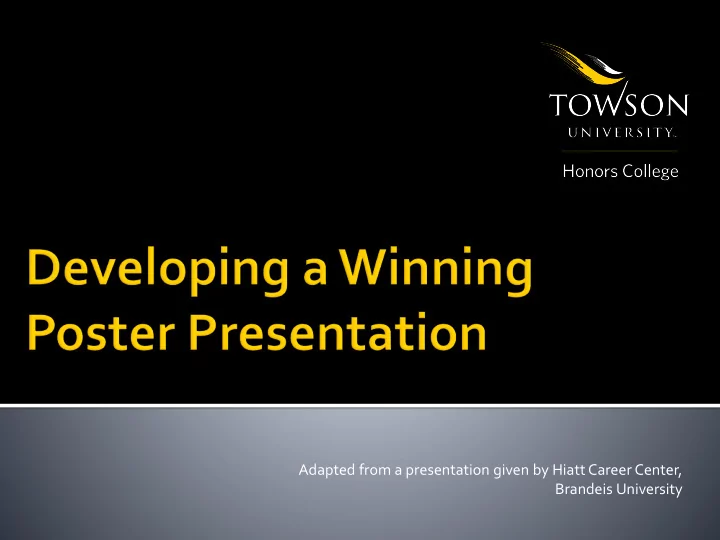

Adapted from a presentation given by Hiatt Career Center, Brandeis University
• Why Present? • Poster Specifications • What’s Your Story? • Goals of Experiential Learning • Aspects of Effective Poster Presentations
Poster presentations are a great opportunity for undergraduates to: • Gain experience in presenting your work in a formal setting • Receive feedback from faculty and peers • Share ideas and learn from other students • Enhance your resume
• A large printed poster • Mounted to a tri-fold board (or another method depending on the conference guidelines) • 48’’ x 36’’ • White or black • Project Title • Name • Year • Contact Info
• What did you do? • Why interesting? Important? • But not ONLY about what you did • Outcomes? Who was affected? • Reflection? How were you affected? • Helpful information/advice to share with others? • Why would others want to know about this?
When creating your poster, remember Experiential Learning is: 1. An Intellectual Challenge • Tackle real-world problems for which there are no answers in the back of the book. • Challenge your powers of observation, analysis and creative thinking. • Test theories against the concrete; experience, create, and prove new theories.
When creating your poster, remember Experiential Learning is: 2. A Practical Experience • Explore the world of a professional in the field. • Ask yourself, “Is this field the right fit for me?” • Sharpen applications for graduate school and employment by documenting skills and experience.
When creating your poster, remember Experiential Learning is: 3. Opportunity for Personal Growth • Develop skills to work in groups or independently. • Appreciate differences in learning style, values, and world view. • Practice taking informed risks, and learn from mistakes as well as successes.
• Begin to make a mental outline • What journey do you want people to take? • What were the biggest issues? • …Unexpected results? • …Proudest achievements? • …Lessons learned? • …Most significant insights? • What are your next steps and future plans?
• Readable • Legible • Well-Organized • Succinct
• Limited time to convey your message to your audience • May have less than 3 minutes per person • What are your most important points? • Choose one memorable message • Avoid grammar & punctuation mistakes • Do the topics resonate with the audience? • Why should they know this? • The “grandmother” rule: Would she understand it?
Spatial organization makes the difference between reaching 95% rather than 5% of the audience. • Audience shouldn’t have to hunt for main idea/takeaways • Space in-between sections; Visually neat • Good flow of logic • Impactful, short titles • Avoid jargon • Borders or mounting sections of text help
• Don’t overwhelm them, entice them! • Think of 1-2 sentences to say to everyone • What are your most important points? Your one memorable message? • Keywords and section headings that make an impact • Pictures and graphs instead of paragraphs
• Show, don’t tell • Less (text) is more • Bullet points • Photos & figures speak volumes and break up sections • Use of color (if you can) • Printing • Border/mounting
May differ depending on the type of poster (Science Research vs. others) • • Challenges Personalized Titles • Successes • Methods • Lessons Learned • Outcomes • Highlights of the • Research Topic/ Experience Problem • Next Steps… where is • Organization/Lab this taking you?
• Proofread! • Get feedback from friends or mentors before printing • Clear & easy to understand? • Clean & well designed? • Memorable message? • Know what you most want to tell people • 1-2 sentence version; 2-3 minute version • Prepare a handout that summarizes the poster and your findings
• Dress professionally and wear comfortable shoes since you will likely be standing for a long period of time • Your body language should be open and inviting for people to stop when they walk by. • Be sure to speak loudly enough to be heard, slow enough that you think your are speaking too slowly, and without fillers like “um,” “uh,” “like,” “you know,” and “okay.”
Recommend
More recommend